Essentials of Bird Watching in Nashville
Bird watching in Nashville offers a rich experience due to its diverse wildlife and numerous habitats. Knowing where to go and understanding the environment is key for effective birding.
Best Locations for Birding
Nashville is home to several prime birding spots. Radnor Lake State Park is notable for its serene environment, featuring over six miles of trails where visitors can observe numerous bird species. The park is particularly rich in waterfowl and songbirds.
Percy Warner Park is another excellent site, known for its varied terrain that supports different bird habitats. Birdwatchers can find species such as warblers, woodpeckers, and hawks throughout the park.
For an urban setting, Shelby Bottoms Greenway offers trails along the Cumberland River. This area attracts migratory birds and provides opportunities to see herons and other waterbirds.
Understanding Bird Habitats
Understanding the types of habitats can enhance the birdwatching experience. Nashville features a mix of wetlands, forests, and open fields, each supporting unique bird species.
Wetlands are crucial for many waterfowl and shorebirds. Areas near rivers and lakes provide food sources and nesting sites.
Forested regions like those in Radnor Lake and Warner Parks are ideal for woodland birds, including various migratory passerines.
Open fields and meadows support ground-nesting birds and are essential for species such as sparrows. Recognizing these habitats allows birdwatchers to anticipate which birds they might encounter on their excursions.
Local Bird Species and Identification
Birdwatching in Nashville offers a diverse range of species that enthusiasts can identify throughout the year. Key species include both waterfowl and songbirds, each with unique characteristics and habitats that make them easier to spot.
Common Birds and Where to Find Them
Nashville provides prime opportunities to observe a variety of common birds. The Great Blue Heron prefers wetlands and can often be seen near lakes and rivers. This large bird is identifiable by its long neck and grayish-blue feathers.
The Northern Cardinal is frequently found in backyards, parks, and wooded areas. Its bright red plumage is a distinguishing feature, making it easy to spot against the foliage.
The American Robin, known for its cheerful song, often appears in open fields and gardens, especially during spring and summer.
For those exploring wooded areas, the Carolina Chickadee is common, recognizable by its black cap and bib. Observers might catch sight of the Red-tailed Hawk soaring above, typically near open fields and cliffs. The elusive Barred Owl can be found in mature forests, while the Purple Martin, a type of swallow, often nests near human habitation, such as birdhouses.
Field Guides and Resources
Several field guides can enhance the birdwatching experience in Nashville. The Sibley Field Guide to Birds of Eastern North America is highly recommended for its detailed illustrations and comprehensive species information.
Online databases and mobile apps, such as eBird and Merlin Bird ID, offer convenient resources for bird identification and tracking.
Local organizations, such as the Tennessee Ornithological Society, provide workshops and events aimed at educating birdwatchers on species and habitats.
Birdwatchers can find additional information through websites that detail local hotspots, including Nashville’s Birding Hotspots. Utilizing these resources ensures an informed and rewarding birdwatching experience.
Seasonal Birding and Conservation
Nashville’s birding scene transforms with the seasons, drawing a variety of migratory species while emphasizing the importance of conservation efforts. Bird watchers can explore numerous local parks and natural areas, each offering unique habitats.
Migratory Patterns and Seasonal Visitors
During spring and fall, Nashville serves as a critical stopover for many migratory birds. Species like the Ruby-throated Hummingbird arrive in late April, seeking nectar-rich flowers. Radnor Lake State Park and Shelby Bottoms Nature Center are prime spots to observe these seasonal visitors.
Fall migration sees an influx of waterfowl, such as ducks and geese, in open fields and along waterfronts. Birdwatching tours in Warner Parks provide guided opportunities to witness diverse avian species during these peak migratory times.
It’s essential to note that migratory patterns are impacted by environmental changes. Understanding these patterns helps avid birders know what to expect throughout the year and encourages responsible birding practices.
Supporting Local Bird Conservation
Conservation plays a vital role in sustaining Nashville’s rich birdlife. Organizations like the Tennessee Ornithological Society lead efforts in protecting habitats crucial for nesting and migration.
Birders can support these initiatives by participating in local clean-up events and habitat restoration projects. Maintaining hiking trails in wooded areas and preserving open fields are critical for supporting local ecosystems.
Additionally, creating bird-friendly environments at home, such as native plant gardens, can foster bird populations. Engaging the community in educational programs raises awareness about the importance of conservation efforts. Nashville’s vibrant birding community relies on both individual actions and collective efforts to ensure a sustainable future for local bird species.
Share this content:

Post Comment
You must be logged in to post a comment.